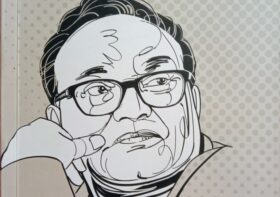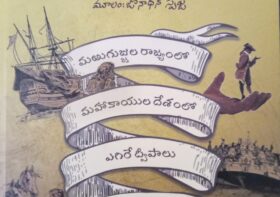Our Draupadi
Guest Column by: Crazyfinger
IN THE FIRST SEVEN PAGES of his book, “The Gospel According to Jesus Christ,” Jose Saramago, the Nobel Prize winner in Literature, describes a “paper and ink” painting of the crucifixion of Jesus Christ. Here are two excerpts:
First,
“Judging from the anguished expression on the man’s face and from his eyes, which are raised to heaven, this must be the Good Thief. His ringlets are another reassuring sign, for it is well known that this is how angels and archangels wear their hair, and so it would appear that the repentant criminal is already ascending to the world of heavenly beings.”
Saramago concludes the first chapter with the following second excerpt:
“Farther back, in the same field where the horsemen execute one last maneuver, a man is walking away but looking back in this direction. In his left hand he carries a bucket, and in his right hand a staff. At the tip of the staff there ought to be a sponge, not easy to see from here, and the bucket, one can safely bet, contains water with vinegar. One day, and forever after, this man will be much maligned, accused of having given Jesus vinegar out of spite and contempt when he asked for water, but the truth is that he offered him vinegar and water because at that time it was one of the best ways of quenching thirst. The man walks away, does not wait for the end, he did all he could to relieve the mortal thirst of the three condemned men, making no distinction between Jesus and the thieves, because these are things of the earth, which will persist on this earth, and from them will be written the only possible history.”
The reason I quote these passages is this. Recently I have been reading the blog discussions, both on this site and on Kalpana Rentala’s blog, on the Central Sahitya Academy Award winning book on Draupadi by Acharya Yarlagadda Laxmi Prasad and once again there was that feeling in me of a strange but familiar disconnect with my own Telugu people. Perhaps the disconnect lies entirely within me. But I cannot be sure of that. So I thought a bit more about where this disconnect is emerging from. The discussion was centered on Draupadi, or more to the point, Laxmi Prasad’s version of Draupadi. I smiled at first because I was happy to see something familiar once again – having begun reading Telugu blogs only recently and been away from Telugu world for nearly twenty years. But soon this happiness turned into an alarm and disconcert. I was surprised at first but disappointed later to realize how disconcertingly strong is the religious narrative of Mahabharatha. By religious I mean the accepted narrative that had always been there, taken at a face value. In fact this religious, unquestioning narrative remains steadily intact throughout the years, unchanging, unfeeling and unforgiving of other views. Reading the comments sections of the two blogs, my experience was as though I was watching a slowly gyrating, thick, sticky, dark morass of opinions stuck in the religious narrative in which a bright young, fresh and agile gold fish of a “modern,” literary narrative was struggling to survive. Why was that? Here I have to tell you something about my first experience of reading the Christian bible.
When I first read the bible I was at first struck by how intensely physical and individual the character descriptions were, especially in the Old Testament. It was a puzzle to me why I was struck so much by this book, especially given I was not a Christian, neither am I now, nor even possess what one would call a religious temperament. Then I realized that I am not the only one who felt this way, and that there is a whole category of literature which carries forward this feeling and develops it. This is the literary, poetic or novelistic reading of the bible. Robert Alter’s books opened up a whole new world of Old Testament to me. Soon I discovered Jan Fokkelman, Frank Kermode, and James Wood.
Over the course of the past few years I began to re-think what a treasure is Mahabharatha, not because it is “an epic,” but because I am convinced that the real treasure lies in individual characters and how starkly individual they are. It is often puzzling to me why we don’t go beyond the traditionalist interpretation of these epics. The character of Draupadi may not be all that interesting to a reader who either refuses to account for the tradition or just not familiar with it (a western reader for example), but given the immensity of the tradition in which she was cast in the book, she is actually one of the most intriguing characters. One easy way to buy into this notion is to think of oneself as a creator of this character. That is what Jose Saramago has done with Jesus Christ, which was my point behind the above illustration from his book. The moment you make that leap, from a mere reader of the epic, to a reader and a creator of a human character Draupadi, a character with her own real complexity as a member of a family, with questions of her own womanhood, her human desires, her human disappointments, her human wishes, and an intense awareness of her own physical body, you have to admit Draupadi becomes immensely more interesting person whom we simply ought to get to know more, as much as we can. Two chasms keep us from becoming intimate with Draupadi. One is our inability to make mainstream a literary reading of her story. Second, a more difficult one, is for men and women to embrace the physical nature of the our bodies and hence, the physicality of our sense of beauty. I would skew the second chasm a bit more towards men, because it is they, not women, who have consistently been afraid of a woman’s body. Start here, down the manly man’s road.




ramanrsimha
@K.Mahesh Kumar
Pl try to write a brief note on “Our Draupadi”
in Telugu..
Sometimes i cant understand English articles.
Crazyfinger
ఇందాకే న్యూస్ లో చూసాను Jose Saramago passed away అని. What a terrible loss…!
CF
కె.మహేష్ కుమార్
I completely agree with you.
Unfortunately by deifying characters from purana’s the “human value” of those characters is successfully assassinated by our culture.